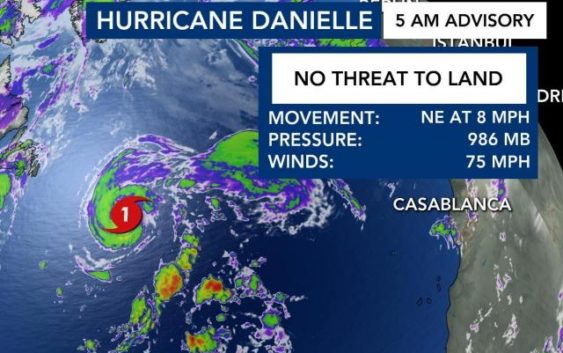- North Carolina's I-40 closure from Hurricane Helene prolonged by new damage, detours in place
- Hurricane Helene survivor rebuilds life in Ashe County with community support
- Charlotte-based marketing agency announces $20,000 Creative Campaign Grant to help communities after Hurricane Helene
- Artists transform hurricane aftermath into hoop-inspired masterpieces at Charlotte exhibit
- NC's cost for Hurricane Helene damage is nearly $60 billion, state says
Hurricane Danielle Continues to Weaken as It Wanders the Open Atlantic

Hurricane Danielle weakened throughout Monday as it drifted across the central North Atlantic Ocean, posing no immediate threat to land, forecasters said.
As of 11 p.m. Eastern, Danielle, the first hurricane of the 2022 Atlantic season, was about 865 miles west-northwest of the Azores and moving northeast at 9 mph, the National Hurricane Center said. Hurricane-force winds extended outward up to 25 miles from the center.
The storm, whose maximum sustained winds had dropped to 80 mph, from 90 mph early Monday, was expected to turn toward the east-northeast by Tuesday night.
The Atlantic hurricane season, which runs from June to November, has had a relatively quiet start, with only three named storms before last week. There were no named storms in the Atlantic during August, the first time that has happened since 1997.
Since Thursday, two tropical storms have formed: Danielle, and Tropical Storm Earl, which was expected to bring 1 to 4 inches of rain over the Leeward Islands, the U.S. and British Virgin Islands and Puerto Rico through Monday.
In the Pacific, Typhoon Hinnamnor was bringing heavy rain and strong winds to eastern China, the Korean Peninsula and Japan after delivering heavy rain on the Philippines. And Tropical Storm Kay, off southwestern Mexico, was expected to strengthen into a hurricane this week as it approached Baja California.
In early August, scientists at NOAA issued an updated forecast for the rest of the Atlantic hurricane season, which predicted an above-normal level of activity. In it, they said that the season — which runs through Nov. 30 — could have 14 to 20 named storms, with six to 10 turning into hurricanes with sustained winds of at least 74 mph.
Three to five of those could strengthen into what NOAA calls major hurricanes — Category 3 or stronger — with winds of at least 111 mph.
Last year, there were 21 named storms, after a record-breaking 30 in 2020. For the past two years, meteorologists have exhausted the list of names used to identify storms during the Atlantic hurricane season, an occurrence that has happened only one other time, in 2005.
Dan Kottlowski, senior meteorologist at AccuWeather, said that hurricanes and tropical storms needed three main things to develop: warm water, vertical wind shear and a moist, unstable atmosphere.
So far this year, the atmosphere has had dry air instead, which has contributed to a slower season, but Kottlowski warned that there was still plenty of time for severe weather to form.
“Over the last seven years, we’ve had a very favorable pattern, but that hasn’t been the case this year,” said Kottlowski, who is also AccuWeather’s lead hurricane forecaster. “It’s still very highly possible that we will see the potential of strong hurricanes to form in the latter part of September to October.”
The links between hurricanes and climate change have become clearer with each passing year. Data show that hurricanes have become stronger worldwide during the past four decades. A warming planet can expect stronger hurricanes over time, and a higher incidence of the most powerful storms — though the overall number of storms could drop, because factors like stronger wind shear could keep weaker storms from forming.
Hurricanes are also becoming wetter because of more water vapor in the warmer atmosphere. Scientists have suggested storms like Hurricane Harvey in 2017 produced far more rain than they would have without the human effects on the climate. Also, rising sea levels are contributing to higher storm surge — the most destructive element of tropical cyclones.
Maria Torres, a National Hurricane Center spokesperson, said people should not lower their guard, even though there have been few major storms so far this year.
“Be vigilant, as things can change, and the season is not over yet,” she said. One storm is enough to make up a season, she added, citing Hurricane Andrew, which devastated South Florida and Louisiana in 1992, an otherwise quiet year. “We still have many months to go in hurricane season.” This article originally appeared in The New York Times.